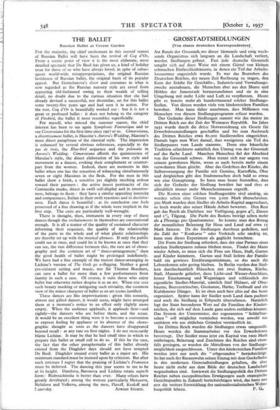THE BALLET
Russian Ballet at Covent Garden
FOR the majority, the chief excitement in this second season of Russian Ballet will have been the revival of Coq d'Or. From a scenic point of view it is the most elaborate, most detailed spectacle that De Basil has given us, a kind of holiday treat for those of us who have always loved, in spite of subse- quent world-vvide misappropriations, the original Russian lavishness of Russian ballet, the original basis of its popular appeal. But Gontcharova's decor and costumes in what is now regarded as the Russian nursery style are saved from appearing bld-fashioned owing to their wealth of telling detail, no doubt due to the curious situation that she had already devised a successful, not dissimilar, set for this ballet some twenty-five years ago and had seen it in action. For the rest, Coq d'Or is beautifully worked out : but it is not a great or profound ballet : it does not belong to the category of Firebird, the ballet it most resembles superficially.
For myself, who missed the summer season, the chief interest has been to see again Symphonie Fantastique and to see Cimarosiana for the first time since 1927 or so. Cimarosiana, a divertissement ballet, is Massine's Aurora's Wedding, Massine's most direct paraphrase of the classical style. The impression is enhanced by several obvious references, especially to the pas de trois, the Blue-bird sequence and the polonaise in Aurora's Wedding. Cimarosiana affords the quintessence of Massine's style, the direct elaboration of his own style and movement as a dancer, evoking their complement or counter- part from the women. Indeed, there are moments in this ballet when one has the sensation of witnessing simultaneously seven or eight Massines in the flesh. For the men in this ballet show a brisk, a sensitive yet slightly mocking ardour toward their partners : the active insect pertinacity of the Commedia masks, direct in swift self-display and in attentive- ness, belongs to them : they have a similar appealing intensity and compactness, Italian in their swift reactions and in decisive- ness. Each dance is beautiful : at its conclusion one feels possessed of a fine drawing as if the whole were implicit in the first step. The exits are particularly well-wrought.
There is thought, then, immanent in every step of these dances though the enchainements in themselves are conventional enough. It is all a matter of the quality of sustained character informing their sequence, the quality of the relationship of the parts to the whole and of what plastic relationships are thereby set up with the musical phrases. If only the public could see at once, and could let it be known at once that they can see, the vast difference between this, the rare art of chore- graphy and the common art of " dance-arrangement," then the good health of ballet might be prolonged indefinitely. We have had a fine example of the merest dance-arranging in Lichine's version of The Gods go a-Begging. Neither a good pre-existent setting and music, nor Sir Thomas Beecham, can save a ballet for more than a few performances from inanity in such a case. Of course, it suits those who enjoy ballet but otherwise rather despise it as an art. When one sees such beauty masking or mitigating such triviality, the common view of the minor character of ballet as an art seems justified.
These dances are-like improvisations : given this scenario, almost any gifted dancer, it would seem, might have arranged them at a moment's notice to an effect only slightly more empty. When the audience applauds, it applauds first—and rightly—the dancers who are before them, and the scene. It would be an excellent thing were it to become a convention to express feeling by applause or its absence of the chore- graphic thought as soon as the dancers have disappeared beyond recall : at any rate on first nights. I do not necessarily blame Lichine. It may be that he had small time in which to prepare this ballet or small call to do so. If this be the case, the fact that the other, paraphernalia of this ballet already existed from the Diaghilev days should not have tempted De Basil. Diaghilev treated every ballet as a major art. His minimum standard must be insisted upon by criticism. But after such stricture I regret that the praising of Lichine's Francesca must be deferred. The dancing this year seems to me to be at its height. Danilova,. Baronova and Lichine retain superb form : Riabouchinska is better than ever. Many others have greatly developed; among the women particularly Merosova, Nelidova and Volkova, among the men, Platoff, Kosloff and






































 Previous page
Previous page